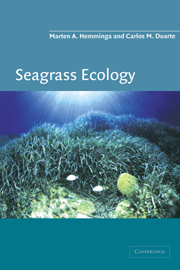4 - Light, carbon and nutrients
Published online by Cambridge University Press: 29 September 2009
Summary
Introduction
As outlined in the first chapter, seagrasses are the only angiosperms that are adapted to a marine submerged existence. Basic requirements for growth are similar for terrestrial angiosperms and seagrasses alike. Life in the marine realm, however, implies exposure to environmental conditions that are considerably different in many respects from those in terrestrial habitats, imposing constraints on the availability of some resources, or calling for specific adaptations to acquire others. In this chapter we will focus on environmental resources imperative for growth in seagrasses, i.e. light, inorganic carbon and nutrients, and on the plant properties relevant to their acquisition and use.
Light
Availability
Photosynthesis provides plants with chemically fixed energy and with carbon skeletons for the variety of biosynthetic processes associated with plant growth and functioning. The penetration of light through natural waters, however, is at least three orders of magnitude less than through air. Light intensity thus rapidly decreases with water depth, and even in clear ocean water virtually no photosynthetically active radiation (PAR; wavelength 350 or 400 to 700 nm) can penetrate beyond a depth of 200 m. Apart from absorption by pure water, particulate and soluble substances also each contribute to the total attenuation of light in the water column. The intensity of absorption varies with the wavelength; the absorption of pure water, for instance, begins to rise as wavelength increases above 550 nm (Fig. 4.1; Kirk, 1983).
- Type
- Chapter
- Information
- Seagrass Ecology , pp. 99 - 145Publisher: Cambridge University PressPrint publication year: 2000
- 3
- Cited by



